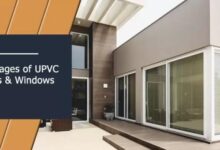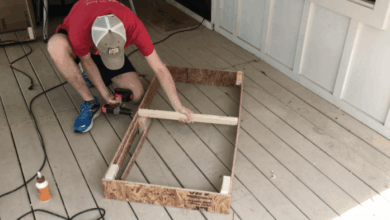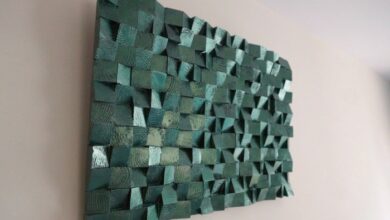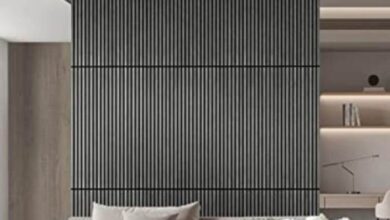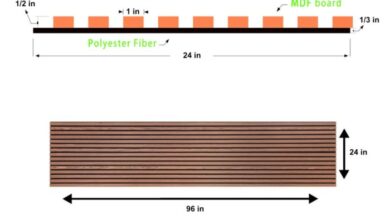Tips for Combining Art Deco & Retro in a Villa
Tips for combining art deco and retro decor in a villa opens a world of design possibilities, blending the glamour of the roaring twenties with the comforting nostalgia of a bygone era. Transforming a villa into a stunning fusion of these styles requires careful consideration of architectural features, furniture choices, and a harmonious color palette. This exploration delves into the key elements needed to create a cohesive and visually captivating space, ensuring a balance between the distinct yet complementary aesthetics.
From defining the core characteristics of each style to navigating the unique challenges of a villa setting, this comprehensive guide provides practical tips and insightful examples. Learn how to seamlessly integrate furniture, lighting, textiles, and decorative elements to achieve a truly exceptional interior design. We’ll uncover how to avoid clashes and create a space that feels both historically inspired and effortlessly contemporary.
Defining the Styles
Art Deco and Retro aesthetics, while both appealing to a sense of timeless design, represent distinct historical periods and stylistic choices. Understanding their unique characteristics is crucial for effectively blending them in a modern setting like a villa. A harmonious integration demands a keen awareness of their divergent elements.The inherent beauty of combining these styles lies in their contrasting qualities.
Art Deco, with its geometric precision and opulent materials, provides a sophisticated backdrop, while Retro’s playful simplicity and bold colors offer a refreshing counterpoint. The challenge lies in balancing these differences to achieve a cohesive and visually compelling result.
Art Deco Design Elements
Art Deco, flourishing in the 1920s and 1930s, is characterized by its streamlined forms, geometric patterns, and luxurious materials. Bold, contrasting colors are often employed, with a strong emphasis on symmetry and precise lines. This style often incorporates elements inspired by ancient civilizations and machine aesthetics.Examples include:
- Geometric patterns, like zigzags, chevrons, and sunbursts, frequently appear in wallpapers, textiles, and furniture.
- Streamlined silhouettes and sculpted forms are hallmarks of furniture design, often featuring chrome accents and polished surfaces.
- Opulent materials such as lacquer, ebony, and brass are used in furniture and decorative objects, conveying a sense of opulence.
- Intricate mosaics and decorative glasswork are commonly seen in interior design, adding a touch of artistry.
Retro Design Elements
Retro design draws inspiration from past decades, typically the 1950s, 1960s, and 1970s. It embraces a simpler aesthetic, incorporating bolder colors and playful patterns, often associated with pop culture and everyday objects of the era. The emphasis is on comfort and functionality.Examples include:
- Bold colors, often seen in primary hues and vibrant secondary shades, are a defining characteristic of retro style.
- Playful patterns, such as florals, geometric shapes, and polka dots, frequently appear in textiles, wallpaper, and home accessories.
- Furniture designs often feature curved lines, a nod to the rounded forms and organic shapes popular in the mid-century.
- The incorporation of iconic objects, such as vintage furniture and household items, adds a layer of nostalgia to the space.
Key Characteristics Distinguishing Art Deco from Retro
Art Deco is characterized by a sophisticated, modern aesthetic, often incorporating opulent materials and geometric patterns. Retro, on the other hand, is more playful and simpler, with an emphasis on bold colors and patterns inspired by pop culture and everyday objects.The use of materials and colors distinguishes the two styles:
- Art Deco favors luxurious materials like brass, ebony, and lacquer, evoking a sense of wealth and elegance.
- Retro emphasizes vibrant colors and patterns, evoking a sense of fun and nostalgia.
Color Palettes and Material Choices
Art Deco often uses a color palette of deep jewel tones, such as emerald green, sapphire blue, and ruby red, combined with metallic accents like gold and silver. Retro embraces bolder and brighter colors, often drawing inspiration from pop culture and incorporating a variety of vibrant hues.Materials differ significantly:
- Art Deco utilizes rich materials like polished wood, lacquered finishes, and brass, creating a luxurious and opulent feel.
- Retro utilizes a wider range of materials, often including plastics, fabrics, and painted wood, creating a more playful and accessible feel.
Historical Contexts
Art Deco emerged in the 1920s and 1930s, reflecting the optimism and technological advancements of the era. Retro design draws inspiration from the mid-20th century, a time of significant social and cultural shifts. Understanding these contexts helps to appreciate the unique characteristics of each style.
Comparison of Art Deco and Retro Aesthetics
| Feature | Art Deco | Retro | Combined |
|---|---|---|---|
| Color Palette | Deep jewel tones, metallic accents | Bold, vibrant colors | Sophisticated jewel tones complemented by pops of retro color |
| Materials | Lacquer, polished wood, brass | Plastics, fabrics, painted wood | Combining luxurious materials with retro fabrics and finishes |
| Patterns | Geometric, symmetrical | Playful, often inspired by pop culture | Geometric patterns with playful accents |
| Silhouettes | Streamlined, geometric | Rounded, organic | Balanced silhouettes |
Villa Considerations
Transforming a villa into a space that seamlessly blends Art Deco and Retro aesthetics demands careful consideration of its architectural attributes, potential pitfalls, and the impact of its unique dimensions. A successful fusion requires a nuanced understanding of the villa’s layout and scale, allowing for a harmonious integration of both styles without compromising the villa’s inherent character.Integrating these contrasting yet complementary styles necessitates a meticulous approach to ensure balance and avoid visual clutter.
The inherent elegance of Art Deco can be beautifully juxtaposed with the relaxed charm of Retro design elements.
Architectural Features of Villas
Villas often boast unique architectural features, such as expansive windows, high ceilings, grand staircases, and elaborate detailing. These features can serve as focal points or as canvases for integrating elements from both styles. For example, a grand staircase can be adorned with Art Deco-inspired balustrades, while the walls surrounding it might feature retro-inspired wallpaper or paneling. Careful consideration of these architectural elements is crucial to achieving a cohesive and visually appealing design.
Challenges of Combining Styles
Integrating Art Deco and Retro aesthetics in a villa presents certain challenges. A key consideration is maintaining visual harmony between the distinct styles. Retro elements can feel dated or out of place if not carefully integrated with Art Deco features. This is where a skilled designer can play a vital role in achieving a successful fusion.
Size and Layout Influence
The size and layout of a villa significantly impact design choices. In a spacious villa, larger, bolder design elements from both styles can be incorporated, whereas a smaller villa might necessitate more subtle and carefully considered design choices. The flow of the layout must also be considered. For instance, an open-plan living area might lend itself well to a Retro-inspired color palette, while a more intimate dining room could feature Art Deco-style embellishments.
Scale and Proportion in Villa Design
Maintaining proper scale and proportion is crucial for creating a visually appealing and balanced space. Large rooms, such as living rooms or dining areas, benefit from bold design choices. In contrast, smaller rooms or hallways might be more suitable for more subtle accents or touches from either style.
Balancing Art Deco and Retro Styles
Achieving a balance between Art Deco and Retro styles involves careful selection and placement of furniture, decor, and accessories. For instance, a sleek Art Deco-style sofa can be balanced with a Retro-inspired coffee table or a pair of vintage armchairs. The use of color palettes is also critical. Art Deco often employs rich, bold colors, while Retro styles often favor more muted or pastel tones.
These colors should be carefully combined to avoid a jarring effect.
Example Floor Plan: Villa Integration
| Area | Art Deco Element | Retro Element |
|---|---|---|
| Living Room | Geometric patterned rug, mirrored wall, dramatic chandelier | Vintage armchairs, leather-bound coffee table, mid-century modern sofa |
| Dining Room | Ornate dining table, metallic accents, bold wallpaper | Retro-inspired dining chairs, vibrant table runner, antique-style lighting |
| Kitchen | Modern cabinetry with sleek lines, metallic appliances | Vintage-inspired tiles, retro-style backsplash, pendant lighting |
| Bedrooms | Rich fabrics, ornate headboards, geometric patterns | Comfortable bedding, vintage lamps, textured rugs |
Color and Lighting
Blending Art Deco and Retro aesthetics requires careful consideration of color palettes and lighting. A harmonious combination of these styles creates a captivating atmosphere, drawing inspiration from the glamour of the former and the warmth of the latter. Thoughtful lighting choices can elevate the overall ambiance, while appropriate fixtures ensure a cohesive visual narrative.Color palettes for Art Deco and Retro styles often present a challenge.
The key lies in finding a balance that avoids overwhelming the space. A good starting point is to select a dominant color, perhaps a deep teal or a rich emerald green, that evokes the vintage charm of the Retro era while also echoing the bold, geometric patterns of Art Deco. Complementary colors like gold, brass, or deep burgundy can add depth and sophistication.
The interplay of these hues should be carefully orchestrated to create a visual narrative that connects both eras.
Color Palette Selection
The selection of color palettes is crucial for achieving a harmonious blend of Art Deco and Retro aesthetics. The key is to identify a dominant color that reflects the characteristics of both styles. For instance, a deep emerald green can evoke the warmth of the Retro era while also echoing the boldness of Art Deco patterns. Supplementary colors, like gold or brass, enhance the visual narrative by adding depth and sophistication.
A cohesive blend of these hues is essential to connect both design eras.
Combining Art Deco and retro styles in a villa requires careful consideration of patterns and colors. A great way to achieve this balance is through easy DIY Art Deco wall decor projects, like creating geometric patterns or incorporating vintage mirrors. These projects, detailed in easy DIY art deco wall decor projects for beginners , can add a unique touch and seamlessly blend the two aesthetics.
Ultimately, the key is to choose pieces that complement each other and create a cohesive, stylish space.
Lighting Considerations
Lighting plays a pivotal role in establishing a cohesive and inviting ambiance in a space combining Art Deco and Retro styles. The use of different lighting types and strategic placement is paramount. Proper lighting design can enhance the overall appeal and transform the space into a captivating environment. Combining ambient, task, and accent lighting is vital for creating layered illumination that respects both styles.
Lighting Fixture Selection
Selecting lighting fixtures is essential to seamlessly integrate Art Deco and Retro elements. The fixtures should reflect the desired atmosphere. Consider incorporating sleek, geometric designs characteristic of Art Deco alongside warm, rounded forms reminiscent of Retro styles. Mixing metallic finishes, like polished chrome or brass, with warm wood tones can create a sophisticated yet inviting aesthetic. Using vintage-inspired pendant lights or modern chandeliers with subtle geometric patterns can seamlessly blend the two styles.
Examples of Successful Combinations
Successful color combinations in Art Deco and Retro settings often involve a harmonious blend of bold and subtle hues. A room showcasing deep emerald green walls, complemented by gold accents and brass light fixtures, can successfully embody both styles. Alternatively, a space with warm beige or cream walls, accented by rich burgundy furniture and copper-toned lighting fixtures, can create a sophisticated Retro ambiance while maintaining a touch of Art Deco elegance.
Design Layout Example
| Zone | Lighting Scheme | Color Palette | Description |
|---|---|---|---|
| Living Area | Ambient: Recessed lighting, Task: Floor lamps with Art Deco-inspired bases, Accent: Chandelier with retro-inspired glass shades | Dominant: Cream, Accent: Gold, Burgundy | A blend of ambient, task, and accent lighting creates a warm and inviting atmosphere. The color palette emphasizes Retro warmth while incorporating Art Deco sophistication. |
| Dining Area | Ambient: Track lighting, Task: Pendant lights with geometric designs, Accent: Wall sconces with vintage-inspired frames | Dominant: Deep teal, Accent: Brass, Gold | The combination of track lighting and pendant lights provides a modern yet vintage feel, while the color palette balances Retro comfort with Art Deco flair. |
| Bedroom | Ambient: Wall-mounted sconces, Task: Reading lamps with rounded bases, Accent: Table lamps with metallic accents | Dominant: Emerald green, Accent: Gold, Beige | Soft, ambient lighting creates a relaxing atmosphere in the bedroom. The color palette draws inspiration from both styles, balancing warmth with elegance. |
Textiles and Fabrics
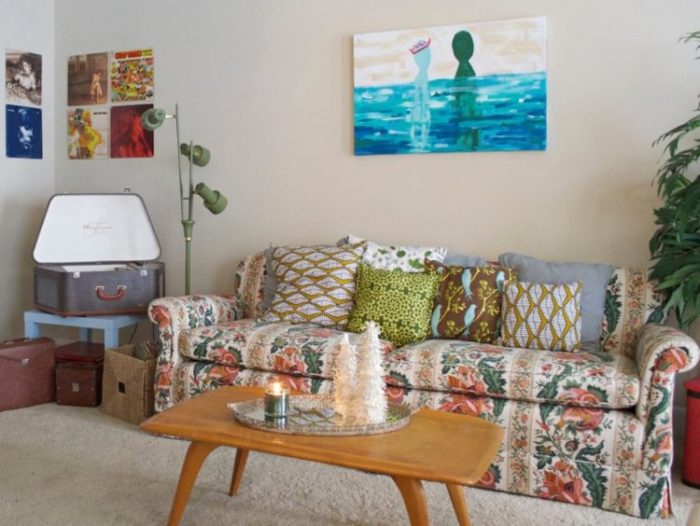
Bringing the Art Deco and Retro styles together in a villa involves carefully selecting textiles and fabrics that echo both aesthetics. These elements are crucial in creating a cohesive and harmonious atmosphere, weaving a sense of timelessness into the space. The choice of fabrics should be strategic, reflecting the architectural grandeur and the comforting retro touches.Combining these two styles demands a balance between the sleek, geometric patterns of Art Deco and the warmer, often more playful, motifs of Retro design.
Textiles provide a tactile layer, enriching the visual appeal and adding depth to the overall design narrative. They are essential in bringing a room to life.
Fabric Selection, Tips for combining art deco and retro decor in a villa
A successful blend of Art Deco and Retro design relies on carefully chosen fabrics. A range of materials can effectively achieve this, from luxurious velvets to soft cottons. Velvet, in rich jewel tones, works particularly well in Art Deco settings, while linens and cottons offer a welcoming retro touch. These can be used in upholstery, curtains, or throws.
A crucial factor in selecting fabrics is ensuring they complement the overall colour scheme and lighting of the villa.
Texture and Pattern
Textiles play a vital role in creating visual interest and depth in a space. Combining patterned and solid fabrics is a key strategy. For instance, a bold, geometric patterned rug can anchor a room, while a solid-coloured velvet sofa adds sophistication. Varying textures can also add dimension. The interplay of smooth silks, textured velvets, and plush wools adds richness and visual interest.
This interplay of textures and patterns is critical for a cohesive, balanced look.
Warmth and Comfort
Creating a sense of warmth and comfort is paramount in villa design. Textiles are key to achieving this. Woolen throws, plush carpets, and soft cushions can instantly make a room feel more inviting. The use of natural fibers like linen and cotton, with their inherent warmth and breathability, further enhance this sense of comfort. The careful selection of textiles can transform a space from merely stylish to truly inviting.
Complementing Patterns and Solids
The strategic use of patterned and solid fabrics is essential. For example, a patterned armchair with a solid-coloured throw can create visual balance. The patterns should complement the overall design and not clash. Careful consideration should be given to the scale of the patterns. Smaller-scale patterns can work well in rooms with larger furniture, while bolder patterns can add drama to more open spaces.
Design Alignment
Choosing textiles that align with the overall design is crucial. Consider the colour palette, the architectural details, and the existing furniture. If the villa’s architecture features a strong geometric design, textiles with corresponding patterns will enhance the cohesiveness. A carefully curated textile scheme can seamlessly integrate the two styles into a cohesive, stunning whole.
Examples of Textiles
A luxurious velvet armchair in a deep emerald green, accented with a subtle geometric pattern, embodies the Art Deco aesthetic. Paired with a retro-inspired throw in a muted mustard yellow, this creates a perfect balance. A patterned rug, featuring a stylized floral motif in muted tones, provides a welcoming retro touch, while maintaining a sophisticated Art Deco ambiance.
A blend of textures is crucial. A plush, patterned rug in a deep burgundy, complemented by a smooth silk cushion in a coordinating shade, creates a luxurious yet inviting space. A soft, linen tablecloth with a subtle abstract pattern, paired with Art Deco-inspired dinnerware, provides a sophisticated and welcoming dining experience. These examples demonstrate how carefully selected textiles can create a harmonious combination of both styles.
Creating a Flow
A seamless blend of Art Deco and Retro styles requires careful consideration of how these distinct aesthetics interact within a villa’s design. The goal is not simply to juxtapose elements, but to create a cohesive narrative that flows organically through the spaces. This involves strategic placement, thoughtful transitions, and a harmonious balance of design choices.Creating a cohesive flow is essential for a successful blend of styles.
This is achieved through careful consideration of transitions, balanced design choices, and the use of shared design elements to unite the disparate elements. This approach ensures a smooth and inviting atmosphere, rather than a jarring contrast.
Transitional Spaces
Transitional spaces, such as hallways, foyers, and staircases, are crucial for mediating between Art Deco and Retro areas. These areas should not simply serve as corridors, but as curated bridges between the distinct styles. Strategic use of color palettes, lighting, and furniture can guide the eye from one style to the next. For instance, a hallway with Art Deco-inspired geometric patterns leading to a Retro-themed sitting room can establish a smooth transition.
Balanced Design Choices
A balanced approach is paramount to avoiding a disjointed or jarring effect. This involves carefully considering the proportion and placement of elements. An overabundance of Art Deco embellishments in a Retro-themed living room would create visual chaos. Similarly, an overwhelming presence of Retro furniture in an Art Deco dining area would disrupt the intended aesthetic. Careful selection and placement of furniture and accessories, in addition to considering the overall scale of the space, are essential.
Cohesive Space Examples
A villa layout can showcase a smooth transition between styles. For example, a dining area with Art Deco-inspired geometric patterns on the wallpaper and a crystal chandelier could flow into a Retro-style living room with a vintage sofa and mid-century modern armchairs. The use of shared elements, such as a specific color palette or material, can further reinforce the connection.
Incorporating both styles can create a unique and personalized home environment.
Room Sequence Design
| Room | Art Deco Elements | Retro Elements | Transitional Features |
|---|---|---|---|
| Entryway | Geometric patterned floor tiles, polished brass sconces | Vintage welcome mat, mid-century modern coat rack | Neutral color palette to connect both styles, a shared design theme for the floor materials |
| Living Room | Sculptural fireplace with Art Deco detailing, mirrored wall panels | Vintage armchairs, mid-century modern coffee table | A shared color palette in the upholstery and accent cushions to establish visual continuity |
| Dining Room | Geometric patterned rug, crystal chandelier | Retro-style dining chairs, a vintage china cabinet | Matching silverware and tableware to connect the two styles, similar color tones for the walls and floors |
| Bedroom | Art Deco-inspired headboard, geometric patterned drapes | Retro-style bed frame, vintage nightstands | Shared color tones for the bedding and accessories, a neutral-toned rug |
Specific Design Ideas: Tips For Combining Art Deco And Retro Decor In A Villa
Blending Art Deco and retro aesthetics in a villa necessitates a careful consideration of design elements to achieve a harmonious and sophisticated ambiance. This involves thoughtfully selecting colors, patterns, and textures that complement both styles, while avoiding a cluttered or overly stylized effect. The key is to create a cohesive narrative that transcends the individual elements, resulting in a cohesive and inviting space.Combining these styles requires a keen eye for detail and an understanding of how to seamlessly integrate geometric patterns, bold colors, and iconic retro shapes.
Thoughtful selection of artwork and wall decor can further enhance the desired effect. A sophisticated yet comfortable atmosphere can be achieved by understanding the principles of balance and proportion. This approach ensures that the resulting design is not only visually appealing but also functionally practical for the villa’s inhabitants.
Incorporating Geometric Patterns
Geometric patterns are a hallmark of Art Deco. Their use can be impactful and visually engaging. Employing these patterns in rugs, upholstery, or wall panels can add a touch of elegance. The careful selection of the pattern’s scale and placement is crucial for avoiding an overwhelming effect. Consider using a combination of bold and subtle patterns to create visual interest without overwhelming the space.
Incorporating Bold Colors and Shapes
Bold colors and distinctive shapes are essential to the retro aesthetic. These elements can be integrated through statement pieces, such as furniture or accessories. Using a palette of rich jewel tones, deep blacks, and striking whites can create a vibrant and luxurious atmosphere. Bold geometric shapes, such as trapezoids or zigzags, can add dynamism to the space.
It’s important to balance these bold choices with softer elements to maintain a comfortable and inviting environment.
Selecting Artwork and Wall Decor
Art Deco and retro-inspired artwork can greatly enhance the overall design. Select pieces that feature bold colors, geometric patterns, or stylized imagery. Retro-inspired prints, photographs, or posters can add a touch of vintage charm. Ensure the chosen artwork complements the existing color palette and overall design scheme. Incorporating mirrors with ornate frames or metallic finishes can add a touch of sophistication.
Creating a Sophisticated Yet Comfortable Atmosphere
A sophisticated yet comfortable atmosphere is paramount. This involves a harmonious blend of luxurious materials, like velvet or leather, with soft textures, like linen or cotton. Incorporating lighting that casts soft, warm tones can also contribute to the desired ambiance. The use of layered lighting, including ambient, task, and accent lighting, creates a warm and welcoming environment.
Strategic placement of furniture and accessories is crucial to maintaining balance and proportion.
Specific Examples of Rooms Incorporating Both Styles
Examples of rooms that seamlessly integrate both styles include:
Living Room: A plush velvet sofa in a deep emerald green or sapphire blue, accented with Art Deco-inspired geometric patterns in the upholstery, paired with retro-style side tables and lamps, creates a sophisticated and comfortable space.
Dining Room: A large dining table with a polished chrome base and a top crafted from a rich wood veneer, surrounded by retro-style chairs with curved backs and bold colors, exudes elegance and warmth. A statement chandelier with Art Deco-inspired design further elevates the dining experience.
Bedroom: A luxurious bed draped with velvet bedding in rich jewel tones, complemented by retro-inspired nightstands and bedside lamps, creates a sophisticated yet inviting space. Art Deco-inspired wall sconces add a touch of elegance. A large mirror with a metallic frame reflects light and adds a touch of glamour.
Last Recap
In conclusion, achieving a successful blend of art deco and retro styles in a villa requires a deep understanding of each design element. By carefully considering the architectural context, selecting appropriate furniture and accessories, and thoughtfully incorporating color and lighting, homeowners can create a truly unique and captivating space. The key is to maintain a harmonious balance between these distinct aesthetics, resulting in a villa that is both historically evocative and contemporary in its appeal.
This detailed guide offers a roadmap to achieving that dream combination.



